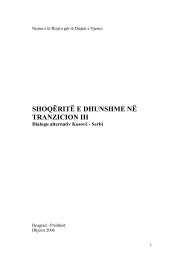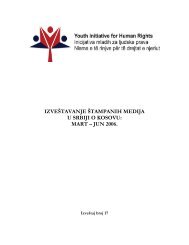Implementation of Transitional Laws in Serbia 2006
Implementation of Transitional Laws in Serbia 2006 - Archive
Implementation of Transitional Laws in Serbia 2006 - Archive
- No tags were found...
You also want an ePaper? Increase the reach of your titles
YUMPU automatically turns print PDFs into web optimized ePapers that Google loves.
<strong>Implementation</strong> <strong>of</strong> <strong>Transitional</strong> <strong>Laws</strong> <strong>in</strong> <strong>Serbia</strong> <strong>2006</strong>Protection <strong>of</strong> Human and M<strong>in</strong>ority Rightsand FreedomsArticle 22Everyone shall have the right to judicial protection when any <strong>of</strong> their human orm<strong>in</strong>ority rights guaranteed by the Constitution have been violated or denied, they shallalso have the right to elim<strong>in</strong>ation <strong>of</strong> consequences aris<strong>in</strong>g from the violation.The citizens shall have the right to address <strong>in</strong>ternational <strong>in</strong>stitutions <strong>in</strong> order to protecttheir freedoms and rights guaranteed by the Constitution.The regulation <strong>of</strong> the protection <strong>of</strong> human and m<strong>in</strong>ority rights alsorepresents a setback compared to the solutions <strong>in</strong> the Small Charter. In theConstitution, it is stated that everyone has the right to judicial protection,while <strong>in</strong> the Small Charter efficient judicial protection was guaranteed 49 . Inthe European Convention, a right to an efficient legal solution is guaranteed 50 .This difference is <strong>of</strong> great significance, s<strong>in</strong>ce not every judicial protection issufficient guarantee for the protection <strong>of</strong> human rights. On these grounds,the European Court for Human Rights has taken the position that the stateis obliged to provide not any, but efficient judicial protection 51 . In this waythis right became a part <strong>of</strong> generally accepted rules <strong>in</strong> Europe, and it isunclear why those who framed the Constitution decided to ignore it <strong>in</strong> thisway. It can also be assumed that the practice <strong>of</strong> the European Court willnot be recognized by the local judicial organs, consider<strong>in</strong>g the fact that it is<strong>in</strong> this case <strong>in</strong> discordance with the Constitution. This is so thanks to theArticle 16 <strong>of</strong> the Constitution, by which <strong>in</strong>ternational contracts must be <strong>in</strong>accordance with the Constitution!In the text <strong>of</strong> the Small Charter, along with the regulations on protection,there were also regulations on who a person can protest to <strong>in</strong> the case <strong>of</strong>the violation <strong>of</strong> human rights 52 . There are no such regulations <strong>in</strong> the <strong>2006</strong>Constitution. Although it can be concluded from the fact that the regulationon constitutional appeals is placed <strong>in</strong> the chapter on the Constitutional courtthat this <strong>in</strong>stitution has jurisdiction over decisions on appeals, howeverthis is not explicitly stated anywhere. Moreover, <strong>in</strong> the Article 167 <strong>of</strong> the49 Article 9, Paragraph 1 <strong>of</strong> the Small Charter, see above under 3650 Article 13 <strong>of</strong> the European Convention, see above under 2951 For example, see the cases: Wille v. Lichtenste<strong>in</strong>, Aksoy v. Turkey or Klass and others v. Germany52 Article 9, Paragraph 2 <strong>of</strong> the Small Charter, see above under 3618











